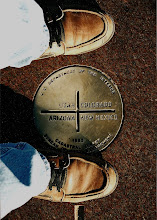
When the wake of World War II washed into Kentucky, it brought German soldiers captured in North Africa to Camp Breckinridge in Union County. During the war, the camp was home to four thousand German prisoners-of-war, and among them was a soldier named Daniel Mayer. He brought with him the mental pictures of the landscape of his native Europe.
I know very little about Mayer, and world would have known little of him had he only fought and died in the sands of the Sahara or in Europe like hundreds of thousands of other soldiers. The Americans captured Mayer, a German native to Czechoslovakia, in 1943 and brought him to America – to Kentucky – to sit out the war as a prisoner. I wish I could travel through time to know how Mayer felt when he first arrived on Kentucky soil.
Was he frightened or even terrified? Maybe he was at ease with his American captors by the time he traveled from Africa to Camp Breckinridge. I try to put myself in the place of Mayer and think about how terribly homesick and afraid I would be if I lost my freedom and put in a strange places thousands and thousands of miles away from my home. What did he think when he first looked out over the flat land surrounding the camp? What impression did Kentucky leave on him that first time his eyes scanned the horizon as he thought about where he was in the world?
In a world and a time fractured by ideological differences, one in which massive armies cut at one another with horrific weapons, Mayer and his captors formed some sort of bond at Camp Breckinridge. When the Americans discovered Mayer’s artistic ability with the paint brush, they paid him a few cents a day to paint scenes from Europe along the walls of the Non-Commissioned Officers’ Club.
Daniel Mayer spent the next two years painting scenes of an idyllic Europe, which through his brush seemed untouched by gruesome battles. He spent 15 months painting a 20X30 foot mural that looks like a massive window into a peaceful world, but he painted many other smaller murals, drawing inspiration out of his memory and from postcards he received from home.
Mayer only ever made it back to his homeland through his memory, however. In 1945, just months before the end of the war, Mayer died of pneumonia at Camp Breckinridge. He is buried at Fort Knox, Kentucky, along with four other German prisoners-of-war.
There is a contrast between the cruelty of war and the inexplicable humanity found in the galling inhumanity of warfare. Daniel Mayer’s story at Camp Breckinridge displays that contrast. He was plucked from the battlefield by his enemy, possibly extending his life, and flown to a land strange to him, a place called “Kentucky.” There he performed an act of humanity amidst the greatest human struggle of modern times. Mayer, through his brush, demonstrated there is something greater than man. He showed that man can love and trust one another.
Today, people can tour the NCO Club at Camp Breckinridge and look at the magnificent scenes Mayer painted. They can see for themselves how one POW took oil paints and brought planks of plywood to life in a time when so many things and lives were destroyed.
